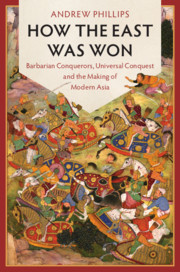Book contents
- How the East Was Won
- LSE International Studies
- How the East Was Won
- Copyright page
- Dedication
- Contents
- Maps
- Preface and Acknowledgements
- Introduction
- 1 From the Rise of the West to How the East Was Won
- 2 The Eurasian Transformation
- 3 The Rise of Asia’s Terrestrial Empires
- 4 European Infiltration and Asian Consolidation in Maritime Asia, 1600–1700
- 5 The Great Asian Divergence
- 6 The East India Company and the Rise of British India, 1740–1820
- 7 Crises of Empire and the Reconstitution of International Orders in South and East Asia, 1820–1880
- Conclusion
- References
- Index
7 - Crises of Empire and the Reconstitution of International Orders in South and East Asia, 1820–1880
Published online by Cambridge University Press: 01 October 2021
- How the East Was Won
- LSE International Studies
- How the East Was Won
- Copyright page
- Dedication
- Contents
- Maps
- Preface and Acknowledgements
- Introduction
- 1 From the Rise of the West to How the East Was Won
- 2 The Eurasian Transformation
- 3 The Rise of Asia’s Terrestrial Empires
- 4 European Infiltration and Asian Consolidation in Maritime Asia, 1600–1700
- 5 The Great Asian Divergence
- 6 The East India Company and the Rise of British India, 1740–1820
- 7 Crises of Empire and the Reconstitution of International Orders in South and East Asia, 1820–1880
- Conclusion
- References
- Index
Summary
This chapter considers the parallel crises that convulsed the British Raj and the Qing Dynasty in the mid-nineteenth century, and that radically reconstituted international orders in both South and East Asia. The chapter proceeds in five sections. The first section presents a comparative overview of the British Raj and the Qing Empire in c. 1820. The second section then outlines the commercial and ideational pressures that propelled an attempted transformation of the EIC’s mode of rule in India, as well as stoking British commercial and military expansion into Qing-dominated East Asia. The third and fourth sections then explore liberalism’s corrosive impact on both the British Raj and the Qing Empire, detailing the crises that nearly destroyed both empires in the mid-nineteeth century. The fifth section concludes with a comparative examination of international orders in South and East Asia after 1860. The mid-century crises of empire that the chapter examines put paid to British attempts to coercively ‘civilize’ Asian polities for a generation, locking in conservative and incorporative diversity regimes that sustained the Raj and the Qing Dynasty down to their destruction in the twentieth century.
- Type
- Chapter
- Information
- How the East Was WonBarbarian Conquerors, Universal Conquest and the Making of Modern Asia, pp. 247 - 295Publisher: Cambridge University PressPrint publication year: 2021

